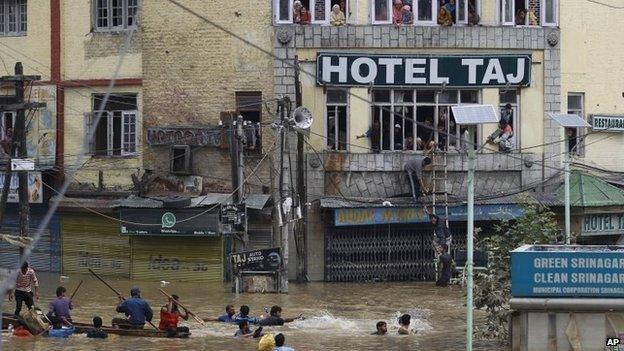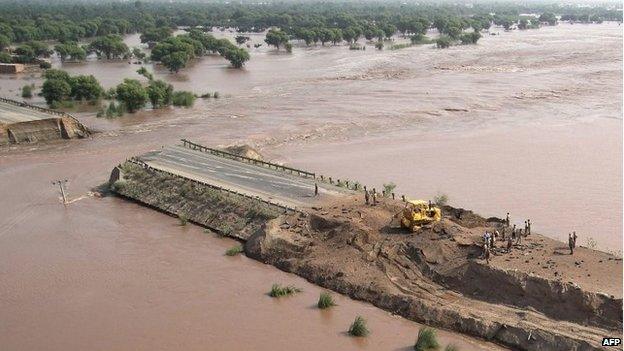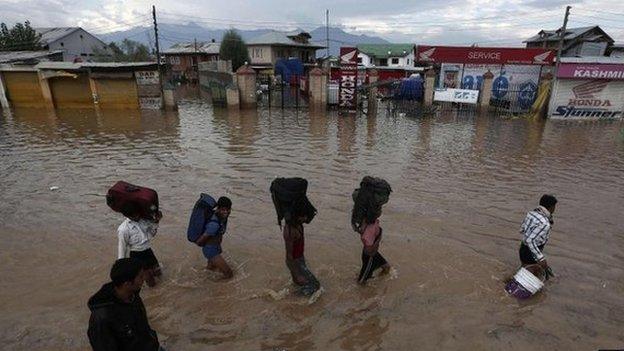Pakistan-India monsoon floods: Averting future disasters
- Published

For most of the year there is little rain, but the monsoon floods can be devastating
After yet another devastating flood, experts say that what Pakistan and India need to do is build more dams and reservoirs.
It makes these annual disasters all the more tragic that for most of the year both countries have little rain.
Yet after leaving more than 450 dead and a swathe of destruction on both sides of the border, much of the water dumped on the Kashmir and Punjab regions in the past 10 days will now be wasted.
Critics say both the Indian and Pakistani governments have repeatedly failed to act on lessons from the past on how to manage their yearly monsoon drenching, even as flood catastrophes become more frequent.

In Indian-administered Kashmir, waters have receded but many people remain stranded
While the two governments are now being battered by complaints over the relief effort, more important in the long-term, water specialists say, is building a better system to capture each new deluge.
Much of the water that has inundated Pakistan's Punjab in this latest disaster came via rivers which originate in the Indian Himalayas, where there has been even more rain.
'Water jihad' accusations
The surge was so big the Pakistani authorities resorted to dynamiting river dykes to divert the flow from urban areas, but thereby flooding farming areas and displacing tens of thousands of people.
Some in Pakistan have attacked India for not controlling this surge, the more extreme even accusing it of a "water jihad" against its long-time rival.
But Ahmer Bilal Soofi, a Pakistani lawyer who specialises in water issues, says his country is as much to blame for the way it has managed the rivers inside its borders, in particular by failing to build more dams to control and store water.

Dykes in Pakistan were breached to divert flood waters
Mr Soofi's words carry weight because he advises Pakistani officials on the Indus Water Commission, a cross-border body set up after the two states signed a water-sharing treaty in 1960., external
The two sides last met just days before this latest flooding crisis, ironically to discuss Pakistani objections to plans for a new Indian dam project., external
But it is perhaps one sign of hope in their turbulent relationship that the treaty has held and they keep meeting.
Better drainage needed
However, experts say India has been just as complacent with water on its own territory.
There too, the authorities are charged with letting the big monsoon storms go to waste, and as Indians know only too well, there is a chronic shortfall in electricity production, which more hydropower schemes could help solve.
Better drainage is also needed and more control of building in flood-prone areas, especially in towns and cities. But "urban India is mindless about drainage" fumes Sunita Narain, a Delhi-based environmentalist, external. "Storm water drains are either clogged, full of garbage and sewage, or just do not exist."

Relief camps like these may become more common as extreme weather events become more unpredictable
But the signs are that these extreme weather events are becoming more common and more unpredictable - which many scientists believe is because of climate change.
The rains that just engulfed India and Pakistan came much later than usual, when most thought the annual monsoon was over.
Similarly, an estimated 5,000 people died in India after being caught by flash floods in June, well before the heavy rains usually start.
In 2010, the river Indus burst its banks over much of central Pakistan killing more than 2,000 people. Several hundred have died in floods every year since.
After the 2010 disaster, Pakistan set up a judicial investigation which came up with a host of recommendations to avoid a repeat.
"But nothing has happened since," says a Pakistani water expert who participated in the 2010 investigation, but asked not to be named.
"After each disaster," he says, "we just go back to sleep again."
- Published11 September 2014

- Published11 September 2014

- Published9 September 2014